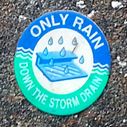 |
April 2014
|
April 2014 // Volume 52 // Number 2 // Tools of the Trade // v52-2tt7
Using Prompts in Extension: A Social Marketing Strategy for Encouraging Behavior Change
Abstract
Extension educators are encouraged to focus more on changing behaviors over increasing knowledge as measures of program success. Prompts are a proven social marketing strategy to encourage behavior change. This article provides a basic overview for using prompts in Extension.
Introduction
Educators are encouraged to focus on behavior change when seeking to improve sustainability in their community, as "[s]tandard knowledge-based educational approaches to behavior change have a disappointing track record" (Frisk & Larson, 2011, p. 2). As such, Extension as a profession is encouraged to focus more on behavioral objectives over knowledge gain when planning and implementing programs (Clements, 1999; Pratt & Bowman, 2008).
Figure 1.
Example of Prompt Used to Prevent People from Polluting Through Storm Drain

Social marketing is a proven approach to creating behavior change and is highly applicable to Extension efforts (Skelly, 2005). This approach borrows principles from traditional marketing and applies them to influencing an audience's behavior to benefit the community and the audience themselves (Kotler & Lee, 2008; McKenzie-Mohr, 2011). One of the primary social marketing models encompasses five distinct steps: 1) selecting what behavior change is desired; 2) analyzing how the audience perceives that behavior; 3) developing strategies to encourage behavior change; 4) piloting strategies on a small scale; and 5) implementing on a large scale and further evaluating the approach (McKenzie-Mohr, 2011). One common strategy for encouraging behavior change is the use of prompts (Kotler & Lee, 2008; McKenzie-Mohr, 2011).
Prompts can be graphic or auditory and "remind us to carry out an activity we might otherwise forget" (McKenzie-Mohr, 2011, p. 84). Slogans, stickers, symbols, and signs can all be prompts when intended to encourage behavior change. This strategy works to encourage behaviors because people can simply forget to do something (Kassirer, 2012).
Have you ever gone to reach for several paper towels after washing your hands in a public facility and been stopped short because of a small sign on the paper towel dispenser, reading "One towel, one dry"? This is a perfect example of simple prompt that works to encourage sustainable behavior. Another favorite example can be found on storm drain grates around the country. Seals that announce "Do not dump! Drains to creek!" are a great example of prompts that are intended to prevent individuals from polluting waterways with grass clippings, fertilizer, and other chemicals. Most people encounter numerous prompts regularly in their daily life that serve as reminders to do something that benefits the community, the environment, and the individual.
Guidelines
Extension professionals may find it advantageous to use prompts to augment their existing or future programs. After behavioral objectives are defined through program planning, agents can assess where and when these actions take place. Some possibilities come to mind. Extension agents can partner with local points of sale and place stickers with clear messages on products or tools that their audience purchases regularly. The message depends on the agent's location and audience. Agents working in horticulture or agriculture might use prompts that remind the audience to:
- Calibrate one's fertilizer spreader regularly;
- Avoid applying chemicals before a heavy rain; or
- Seek positive identification of pests and diseases, through Extension resources, prior to treatment.
Calendars can be excellent prompts and can provide reminders throughout the year from agents working in any discipline. Further, in-store displays, posters, clothing, and yard signs can also serve as prompts.
McKenzie-Mohr (2011) and Kassirer (2012) present guidelines for using this social marketing strategy. The following list summarizes these best management practices with an emphasis on applying prompts to Extension programming.
- Prompts should be used to cue behaviors that people are likely to do. (Consider a behavior that your Extension program addresses that people generally favor—this is not the approach for debated issues.)
- Develop prompts to be highly conspicuous. (Make sure they are placed where Extension clients will notice them.)
- Prompts should be simple to understand. (If clients do not understand the cue, they will not take the action.)
- Use prompts as close as possible to the time and place where the behavior will take place. (Place prompts on lawn equipment and garden products to encourage landscape behaviors.)
- Use prompts to encourage people to do something (such as making sure irrigation systems are set correctly) as opposed to avoiding something (such as irrigating in the rain) for maximum efficacy.
Conclusion
Using prompts is just one of many proven strategies in the social marketing toolbox that can be used to encourage behavior change. Extension professionals should consider building prompts into their programming to maximize their outcomes.
References
Clements, J. (1999). Results? Behavior change! Journal of Extension [On-line], 37(2) Article 2COM1. Available at: http://www.joe.org/joe/1999april/comm1.php
Frisk, E., & Larson, K. L. (2011). Educating for sustainability: Competencies & practices for transformative action. Journal of Sustainability Education, 2, 1-20.
Kassirer, J. (2012). Prompts. Retrieved from: http://www.toolsofchange.com
McKenzie-Mohr, D. (2011). Fostering sustainable behavior (3rd ed.). Canada: New Society Publishers.
Pratt, C., & Bowman, S. (2008). Principles of effective behavior change: Application to Extension family educational programming. Journal of Extension [On-line], 46(5) Article 5FEA2. Available at: http://www.joe.org/joe/2008october/a2.php
Skelly, J. (2005). Social marketing: Meeting the outreach challenges of today. Journal of Extension [On-line], 43(1) Article 1IAW1. Available at: http://www.joe.org/joe/2005february/iw1.php




